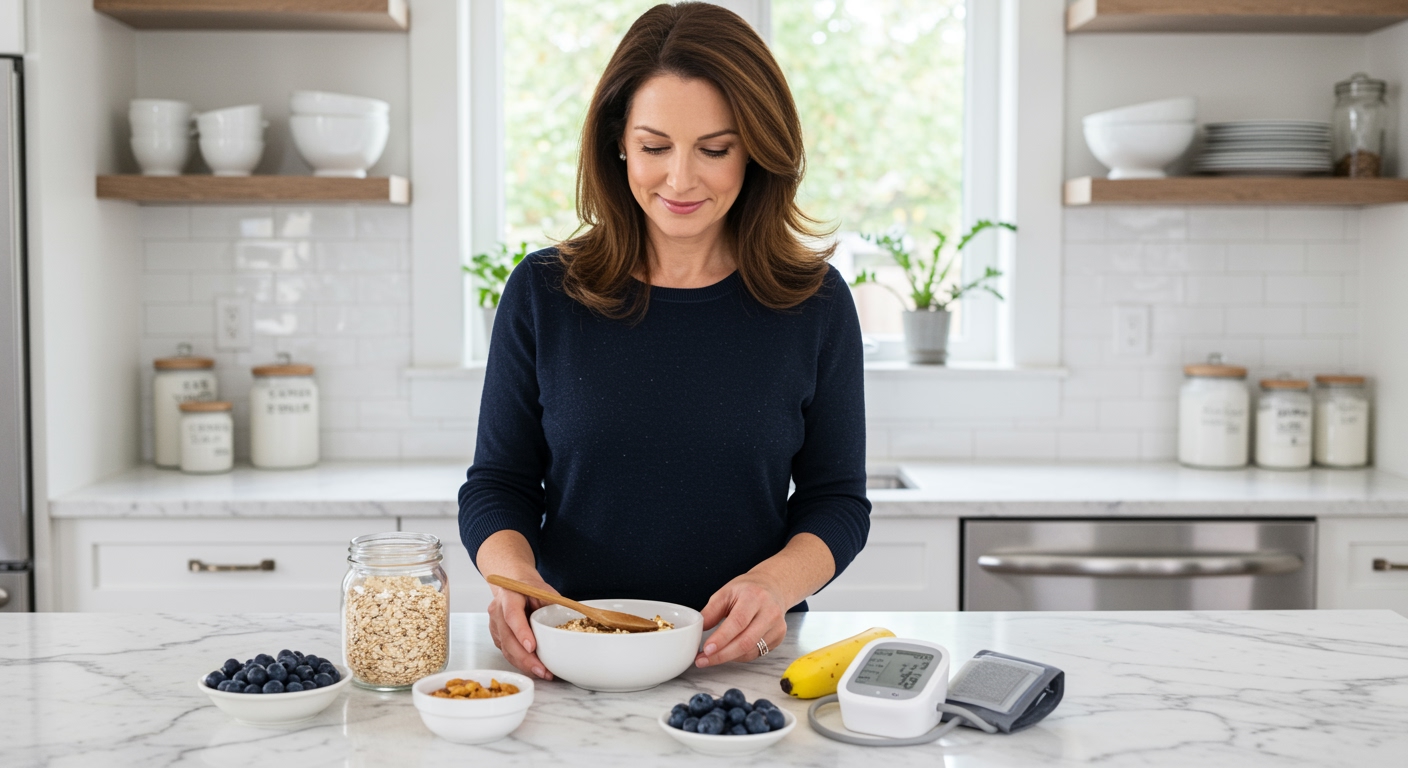✪ Key Takeaway: Oatmeal can help stabilize blood pressure through beta-glucan fiber that improves arterial function and reduces inflammation.
Introduction
Your morning bowl of oatmeal might be doing more for your heart than you realize.
You probably started eating oatmeal because someone told you it lowers cholesterol, but now you wonder if it actually helps with blood pressure too.
Hi, I am Abdur, your nutrition coach and today I am going to explain exactly how oatmeal affects your blood pressure and whether it deserves a place in your daily routine.
What Makes Oatmeal Special For Blood Pressure?
The secret lies in a unique type of soluble fiber called beta-glucan that makes up about 4% of oats by weight.
This fiber forms a gel-like substance in your digestive system that does much more than just slow digestion.
Beta-glucan triggers a cascade of beneficial changes in your cardiovascular system that directly impact blood pressure regulation.
When you eat oatmeal regularly, this fiber helps your blood vessels become more flexible and responsive to changes in blood flow.
Research shows that people who consume at least 3 grams of beta-glucan daily experience measurable improvements in arterial function within just 6 weeks.
One cup of cooked oatmeal provides approximately 2 grams of beta-glucan, so you need about 1.5 cups daily to reach the therapeutic threshold.
The fiber also helps reduce systemic inflammation, which plays a major role in blood pressure elevation and cardiovascular disease progression.
✪ Fact: Steel-cut oats contain slightly more beta-glucan than rolled oats due to less processing.
How Does Beta-Glucan Actually Lower Blood Pressure?
Beta-glucan works through multiple pathways in your body to create a blood pressure lowering effect.
First, it binds to cholesterol in your intestines and removes it from your body before it can enter your bloodstream.
Lower cholesterol levels mean less plaque buildup in your arteries, which allows blood to flow more easily and reduces the pressure against arterial walls.
Second, beta-glucan stimulates the production of nitric oxide in your blood vessel lining.
Nitric oxide acts as a natural vasodilator, causing your blood vessels to relax and widen, which immediately reduces blood pressure.
Third, this fiber helps regulate your body’s inflammatory response by reducing the production of inflammatory markers like C-reactive protein.
Chronic inflammation damages blood vessel walls and makes them less flexible, contributing to higher blood pressure over time.
✪ Pro Tip: Eat oatmeal with berries to boost nitric oxide production even more through natural antioxidants.
What Does The Research Actually Show?
Multiple clinical studies have demonstrated that regular oatmeal consumption can produce meaningful reductions in both systolic and diastolic blood pressure.
A 2022 meta-analysis of 18 randomized controlled trials found that people who ate oats daily experienced an average reduction of 2.7 mmHg in systolic pressure and 1.5 mmHg in diastolic pressure.
While these numbers might seem small, they translate to a 5-9% reduction in cardiovascular disease risk at the population level.
The effects become more pronounced in people who already have elevated blood pressure.
One study specifically targeting individuals with mild hypertension showed reductions of up to 7 mmHg systolic and 5 mmHg diastolic after 12 weeks of daily oat consumption.
The key finding across all studies is that consistency matters more than quantity.
People who ate moderate amounts of oatmeal daily for extended periods saw better results than those who consumed large amounts sporadically.
✪ Note: Results typically become noticeable after 4-6 weeks of consistent daily consumption.
Are All Types Of Oatmeal Equally Effective?
Not all oatmeal products deliver the same blood pressure benefits, and the processing method makes a significant difference.
Steel-cut oats undergo minimal processing and retain the highest concentration of beta-glucan fiber.
Rolled oats are steamed and flattened, which slightly reduces their fiber content but still provides substantial cardiovascular benefits.
Instant oatmeal packets often contain added sugars and sodium that can counteract the blood pressure lowering effects of the oats themselves.
The added sodium is particularly problematic because it can cause fluid retention and increase blood pressure in sensitive individuals.
Flavored varieties typically contain 150-300mg of sodium per serving, which represents 10-20% of the daily recommended limit.
For maximum blood pressure benefits, choose plain varieties and add your own natural flavorings like cinnamon, berries, or a small amount of honey.
✪ Pro Tip: Check the ingredient list and choose oatmeal with only one ingredient listed: oats.
How Much Oatmeal Do You Need For Blood Pressure Benefits?
The optimal amount for blood pressure benefits is approximately 40-50 grams of dry oats daily, which equals about one cup of cooked oatmeal.
This serving size provides roughly 2 grams of beta-glucan fiber, which research suggests is the minimum effective dose for cardiovascular benefits.
You can split this amount throughout the day if eating a full cup at once feels too heavy.
Some people prefer to eat half a cup at breakfast and add oat flour to smoothies or baked goods to reach their daily target.
The timing of consumption does not appear to significantly impact the blood pressure benefits, so you can eat oatmeal whenever it fits best into your schedule.
However, eating oatmeal earlier in the day may help you maintain more stable blood sugar levels, which indirectly supports healthy blood pressure.
Remember that these benefits accumulate over time, so consistency is more important than perfect portion sizes.
✪ Fact: One cup of cooked oatmeal contains about 150 calories and 4 grams of total fiber.
The Bottom Line
Oatmeal can indeed help stabilize blood pressure through its unique beta-glucan fiber content, but it works best as part of an overall heart-healthy lifestyle rather than a standalone solution.
Small daily choices create big health changes over time, and adding a simple bowl of oatmeal to your morning routine represents one of the easiest steps you can take for your cardiovascular health.
I would love to hear about your experience with oatmeal and blood pressure in the comments below, or if you have any questions about incorporating more heart-healthy foods into your daily routine.
References
At NutritionCrown, we use quality and credible sources to ensure our content is accurate and trustworthy. Below are the sources referenced in creating this article:
- PubMed: Oat Beta-Glucan and Blood Pressure
- PMC: Cardiovascular Benefits of Oats
- Cleveland Clinic: How Healthy is Oatmeal
- PMC: Oat Fiber and Hypertension





